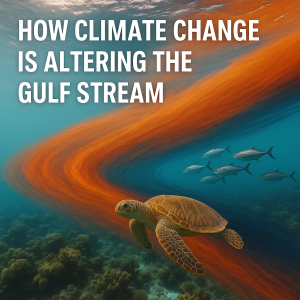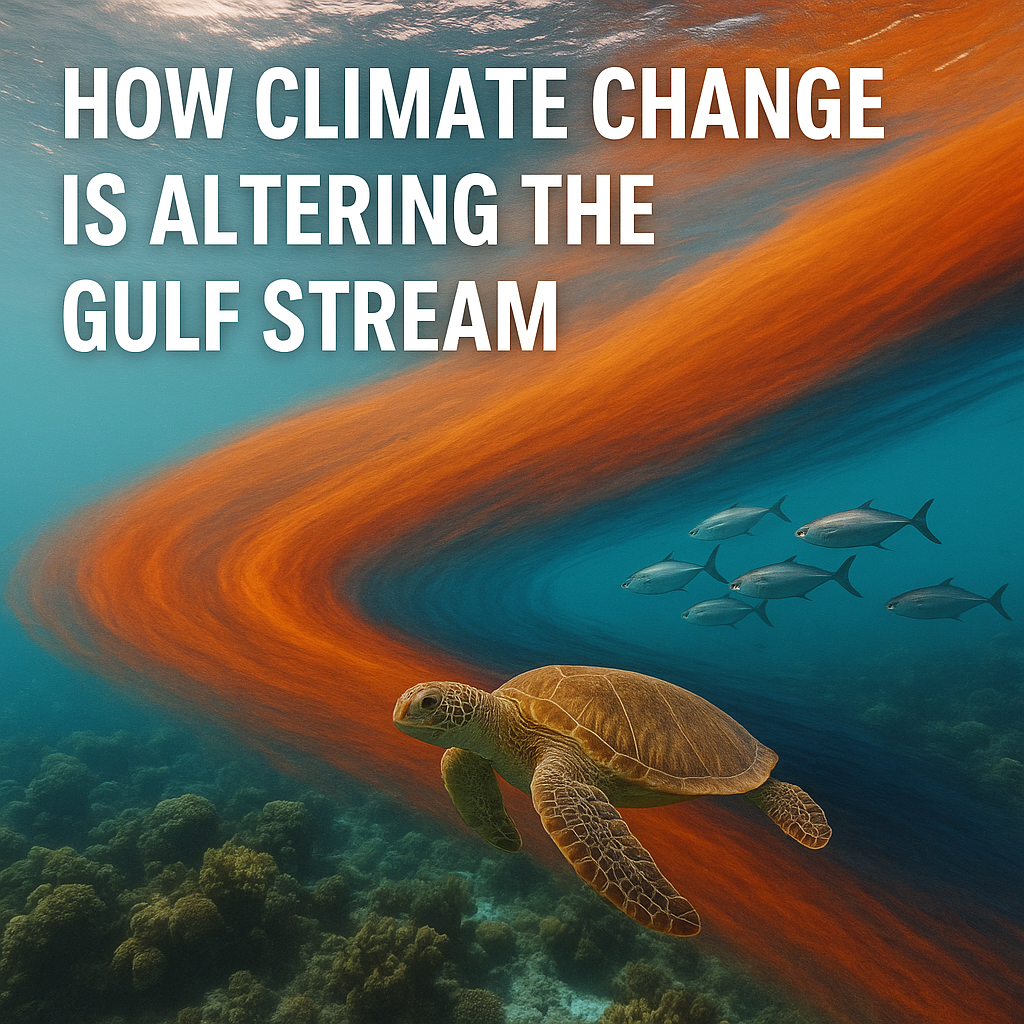 Discover how climate change is disrupting the Gulf Stream, one of the Atlantic Ocean’s most important currents. Explore scientific insights, maritime implications, and real-world case studies in this comprehensive, human-friendly guide.
Discover how climate change is disrupting the Gulf Stream, one of the Atlantic Ocean’s most important currents. Explore scientific insights, maritime implications, and real-world case studies in this comprehensive, human-friendly guide.
The Gulf Stream is more than just a powerful ocean current. It’s the beating heart of the Atlantic’s climate engine, playing a vital role in regulating temperatures, weather patterns, and maritime trade conditions from the Caribbean to northern Europe. But this massive current is now showing signs of distress. Scientists warn that climate change is slowing down the Gulf Stream system — and the consequences may be global.
This article explores what’s happening, why it matters, and how maritime stakeholders are adapting to these changes.
Why the Gulf Stream Matters to Maritime Operations
Imagine the Atlantic Ocean as a vast conveyor belt. The Gulf Stream is a crucial part of it, transporting warm surface water from the Gulf of Mexico up the U.S. East Coast and across to Europe. Formally known as part of the Atlantic Meridional Overturning Circulation (AMOC), this system:
- Helps regulate the global climate by redistributing heat
- Supports major fishing grounds (like the Grand Banks and Newfoundland)
- Reduces ice formation in key shipping lanes in the North Atlantic
- Drives weather systems that affect port operations, insurance risk, and maritime logistics
Without the Gulf Stream’s consistent flow, everything from hurricane intensity to fish migrations to port infrastructure resilience could be thrown off balance.
The Science Behind a Slowing Gulf Stream
The Gulf Stream’s strength depends on a delicate balance of warm and cold water, and of salty and fresh water. As warm water moves northward, it cools and sinks, dragging more warm water up behind it. But climate change is throwing a wrench into this mechanism.
According to a 2021 study published in Nature Climate Change, the AMOC is now at its weakest in over 1,000 years. The key culprits?
- Melting Greenland ice sheets are flooding the North Atlantic with freshwater, which is lighter and doesn’t sink easily.
- Rising global temperatures warm the surface water, reducing the temperature contrast needed to drive the current.
- Changes in precipitation patterns are adding even more freshwater from rain and rivers.
This combination weakens the sinking motion that powers the overturning circulation — in effect, slowing the Gulf Stream.
Observed Impacts on the Maritime Industry
The weakening of the Gulf Stream isn’t just a distant climate warning — it’s already making waves in the shipping world.
Unpredictable Weather and Routing Challenges
A slower Gulf Stream means more extreme weather events in the North Atlantic. For example, colder European winters and stronger U.S. East Coast hurricanes are becoming more frequent. For shipping companies, this translates into:
- Increased insurance premiums due to higher weather-related risk
- More detours and route changes to avoid storm clusters
- Heavier reliance on real-time weather routing systems
DNV and Lloyd’s Register have both noted that climate modeling is now essential in futureproofing vessel design and voyage planning.
Shifts in Fish Stocks and Port Economies
The Gulf Stream’s changes are already affecting fisheries. Cold-water species like cod and haddock are retreating northwards, while warmer-water species such as mackerel are becoming more dominant in regions like the UK and Canada. According to the World Ocean Review (2022), this impacts coastal economies reliant on traditional species — and alters fishing port infrastructure demands.
Impact on Atlantic Ports
Slower currents also lead to localized sea level rise along the U.S. East Coast. This phenomenon, known as dynamic sea level rise, threatens ports like Charleston, Savannah, and Norfolk. The U.S. Maritime Administration (MARAD) now incorporates Gulf Stream data into resilience planning for these Atlantic ports.
Real-World Case Studies
Greenland Melt and Canadian Maritime Ice Hazards
The Canadian Coast Guard has reported increased iceberg presence in shipping lanes south of Newfoundland, traced back to accelerated Greenland ice melt. This raises risks for bulk carriers and oil tankers transiting to Europe.
European Cold Snaps and Energy Shipping
In February 2021, a major disruption in the Gulf Stream contributed to record cold snaps across parts of Europe. LNG shipments to Northern Europe faced delays and port congestion due to frozen river systems and limited unloading infrastructure.
Caribbean Heatwaves and Cruise Impacts
Warmer waters in the tropics, a side effect of slower Gulf Stream heat redistribution, have led to multiple mass coral bleaching events in the Caribbean. This not only hurts marine biodiversity but also affects cruise tourism — a vital source of revenue for small island nations.
Technologies and Scientific Monitoring
Tracking changes in the Gulf Stream is no small task. Fortunately, the scientific and maritime communities are investing in new tools:
- Argo floats: These robotic devices measure temperature and salinity across ocean depths.
- Satellite altimetry: ESA’s Copernicus and NASA’s Jason satellites track sea surface height and current speeds.
- eDNA monitoring: Helps detect species shifts due to oceanographic changes.
- Maritime digital twins: Used by Wärtsilä and other firms to simulate current changes and optimize routing.
According to the IMO’s 2023 report on Maritime Climate Adaptation, integrating these technologies into fleet management is now considered best practice.
Challenges and Solutions for Maritime Stakeholders
The impacts of a weakening Gulf Stream are complex — and so are the solutions. However, proactive steps are being taken.
Challenges:
- Rising insurance and infrastructure costs
- Reduced predictability of transatlantic shipping times
- Shifting ecosystem services affecting fisheries and aquaculture
Solutions:
- Port adaptation projects: Halifax, Rotterdam, and Lisbon have implemented new tidal defenses and floating terminals.
- Ship design resilience: New hull forms and routing systems are being trialed to better handle erratic current patterns.
- International cooperation: Through IMO’s GHG Strategy and IHO’s ocean observation programs, data sharing and early warning systems are improving.
The Future Outlook
If current emissions trends continue, the IPCC warns that the AMOC could weaken by another 34–45% by 2100 — or possibly collapse altogether. While a full shutdown is still considered unlikely this century, the weakening trend is real.
For maritime actors, this is a call not for panic, but for preparation. Port authorities, shipping firms, and fisheries managers must include oceanographic modeling in their long-term planning.
There’s hope too: mitigation measures like emissions reductions, restoration of coastal ecosystems, and scientific cooperation can slow — or even stabilize — the Gulf Stream’s decline.
Frequently Asked Questions (FAQ)
1. What is the Gulf Stream and why is it important?
It’s a major Atlantic Ocean current that transports warm water from the Gulf of Mexico toward Europe, regulating climate and aiding navigation.
2. How is climate change affecting the Gulf Stream?
Increased freshwater from melting ice and warming temperatures are slowing the current’s strength.
3. What are the risks for shipping companies?
Higher storm risk, longer voyage times, and less predictable routing, especially across the North Atlantic.
4. Are ports affected by changes in the Gulf Stream?
Yes. Dynamic sea level rise and increased flooding risks are already affecting ports along the U.S. East Coast and Europe.
5. What can maritime industries do?
Adopt adaptive infrastructure, integrate oceanographic models, and participate in global data-sharing initiatives.
6. Has the Gulf Stream ever stopped before?
During the last Ice Age, a sudden influx of freshwater did cause a temporary halt, but current dynamics are different.
7. Will the Gulf Stream collapse soon?
Most models say it’s unlikely to collapse this century, but significant weakening is already underway.
Conclusion
The Gulf Stream isn’t just a current — it’s a lifeline. For centuries, it has shaped the Atlantic maritime world, from trade winds to naval strategies. But now, climate change is reshaping it in return.
For maritime professionals, students, and enthusiasts, understanding the Gulf Stream’s future is no longer optional. It’s vital to sustainable planning, safe shipping, and ocean stewardship.
Let’s not wait for the current to stop. Let’s navigate with knowledge.
References
- IPCC. (2021). Sixth Assessment Report. https://www.ipcc.ch/report/ar6/wg1/
- NOAA. (2023). Climate and Ocean Currents. https://oceanservice.noaa.gov/education/tutorial_currents/
- Nature Climate Change (2021). [Article on AMOC weakening] https://www.nature.com/articles/s41558-021-01097-4
- IMO. (2023). Maritime Climate Adaptation Report. https://www.imo.org/en/OurWork/Environment/Pages/ClimateChange.aspx
- World Ocean Review. (2022). Gulf Stream special issue. https://worldoceanreview.com
- DNV. (2023). Climate and Insurance Risks. https://www.dnv.com/maritime/index.html
- Lloyd’s Register. (2023). Future of Shipping Insights. https://www.lr.org/en/insights/
- MARAD. (2023). Port Infrastructure & Climate. https://www.maritime.dot.gov/
- European Space Agency. (2024). Copernicus Ocean Monitoring. https://www.copernicus.eu/en
- Wärtsilä. (2024). Digital Twin Technology in Ocean Forecasting. https://www.wartsila.com/

